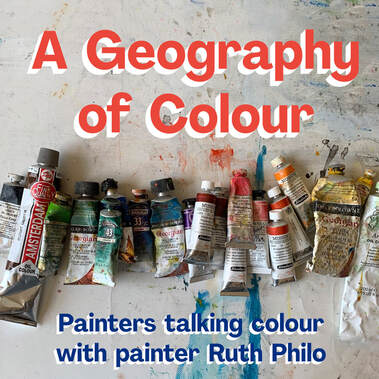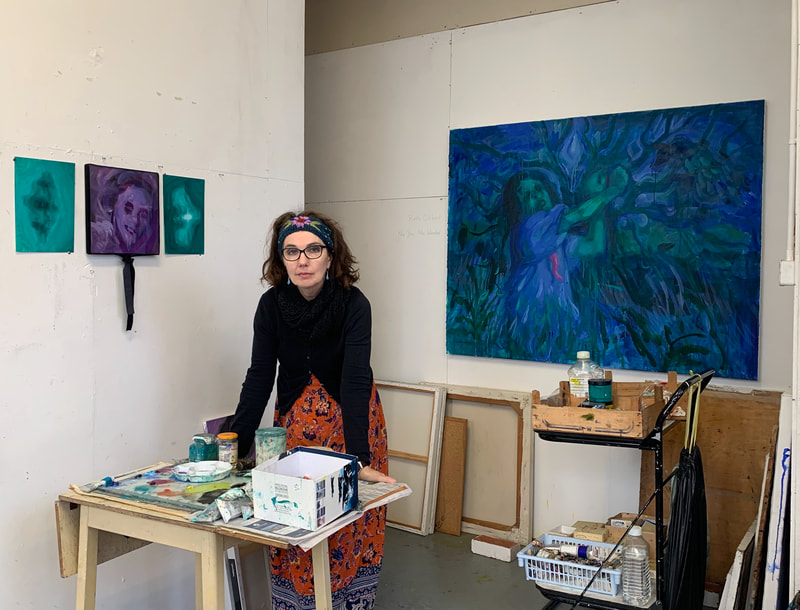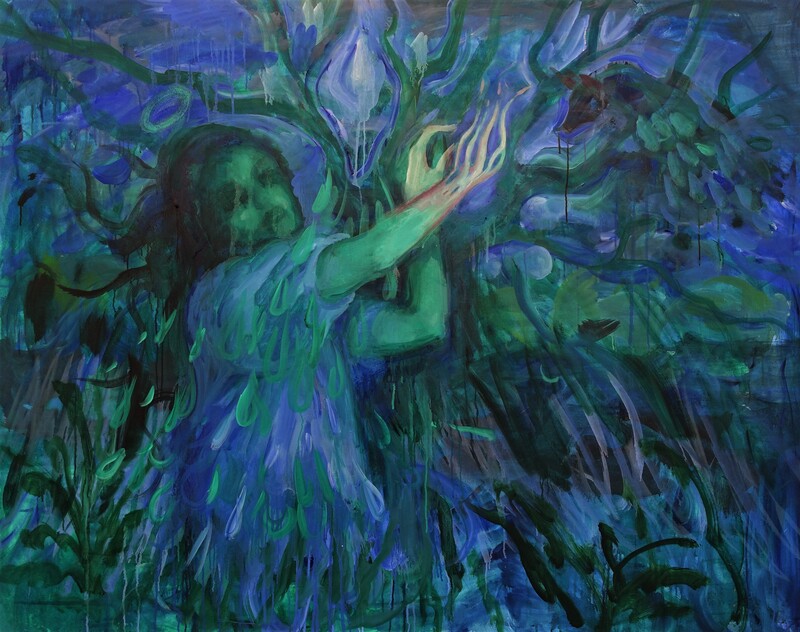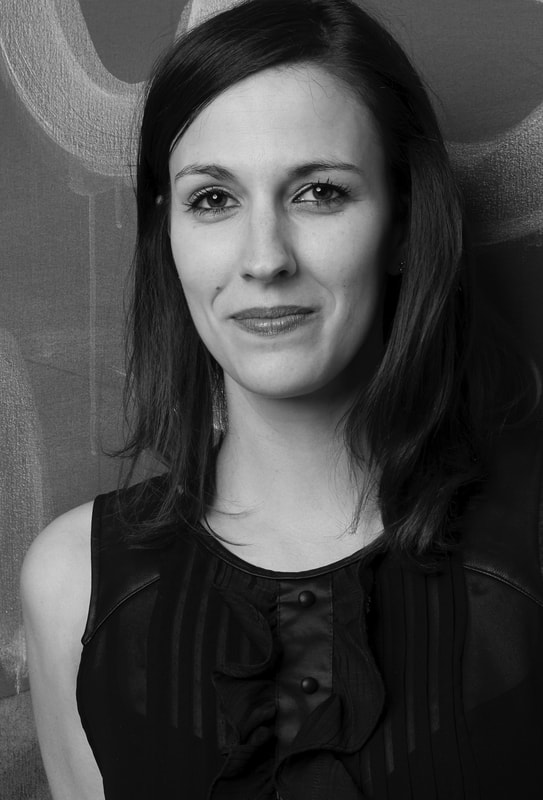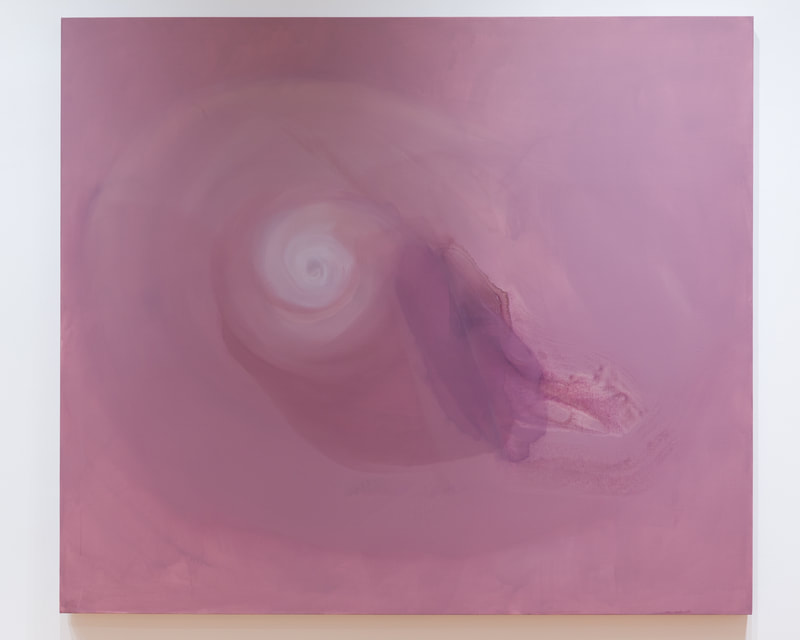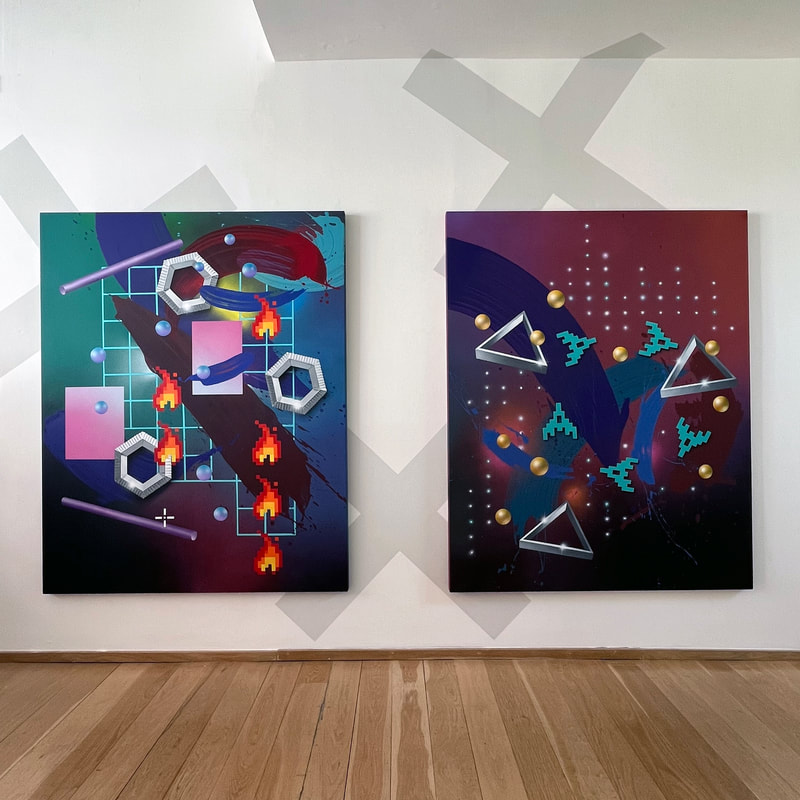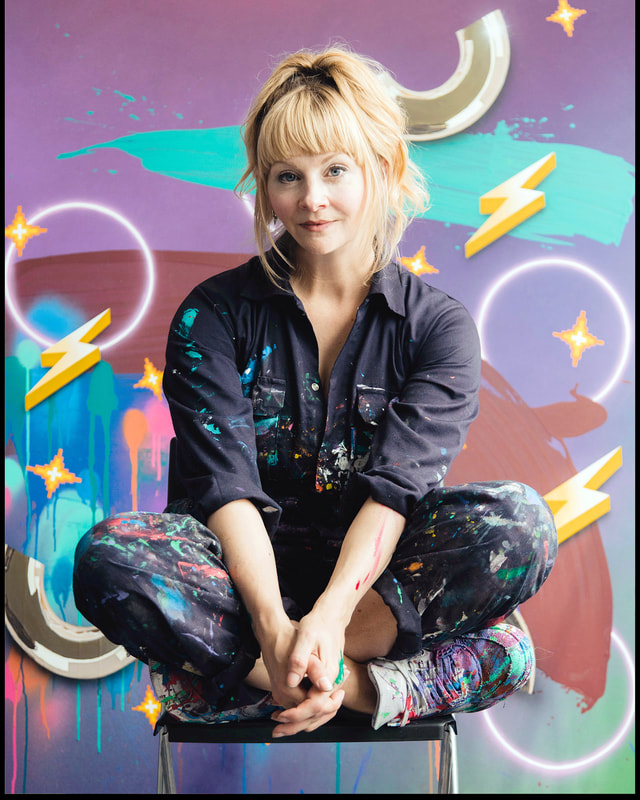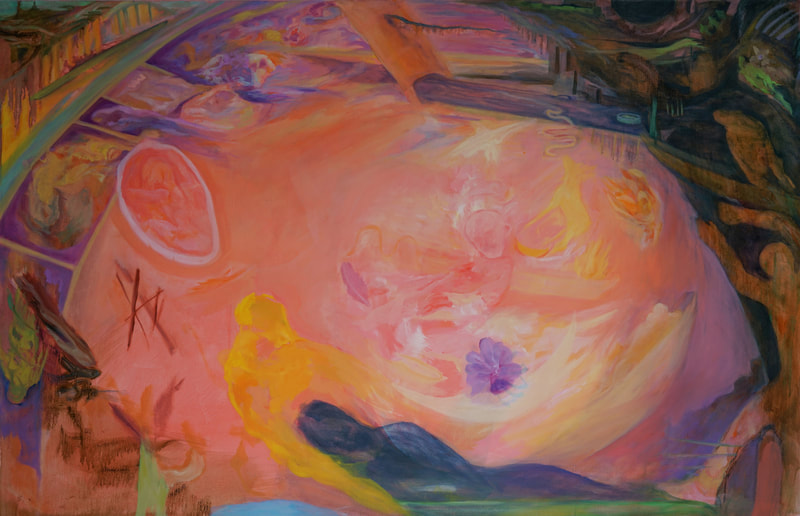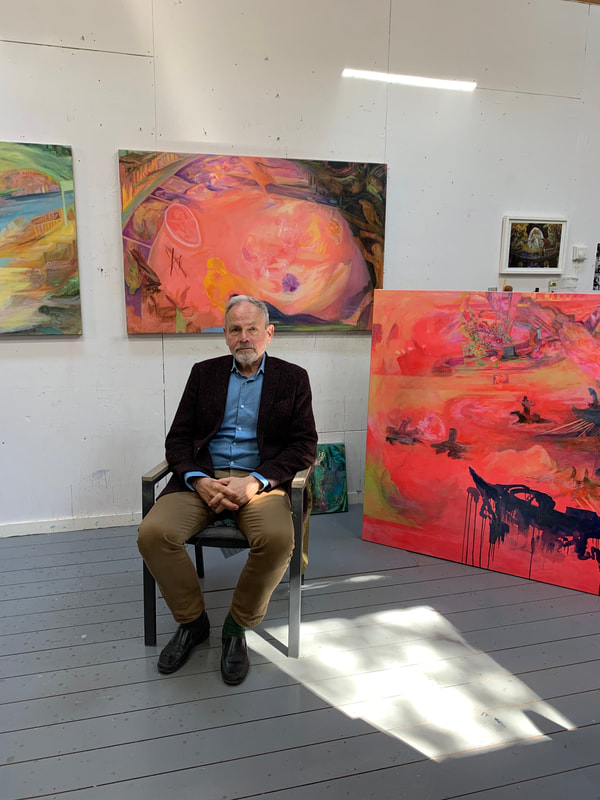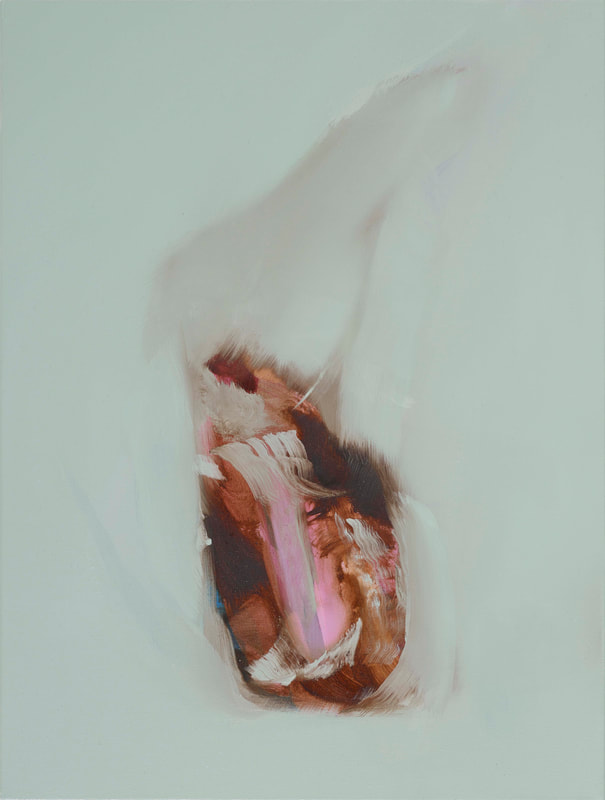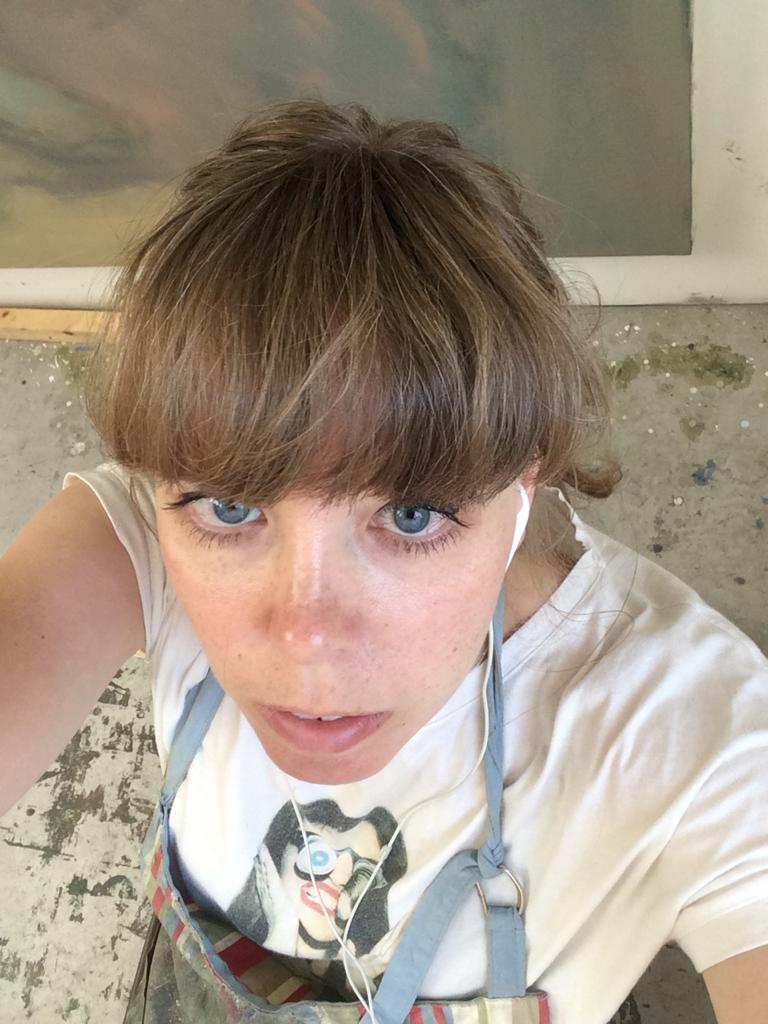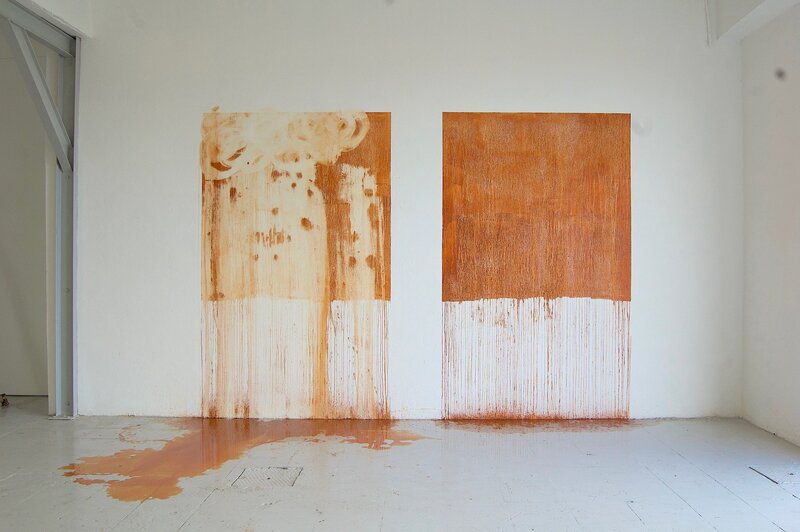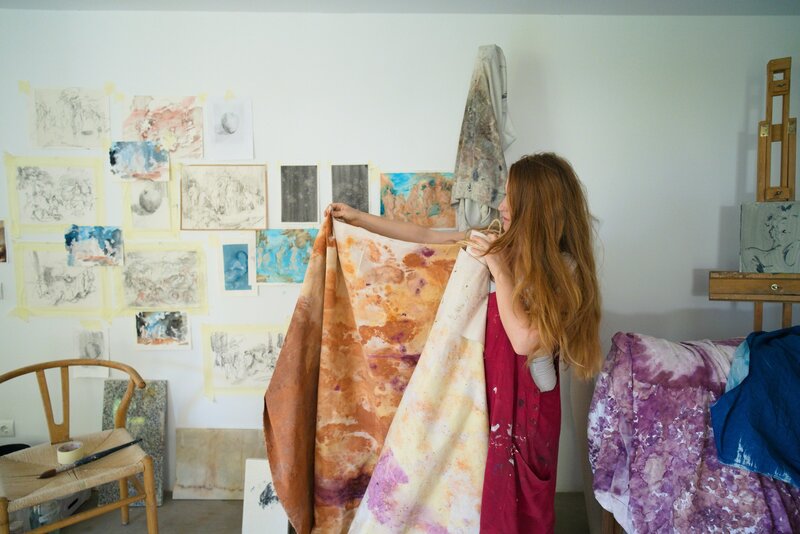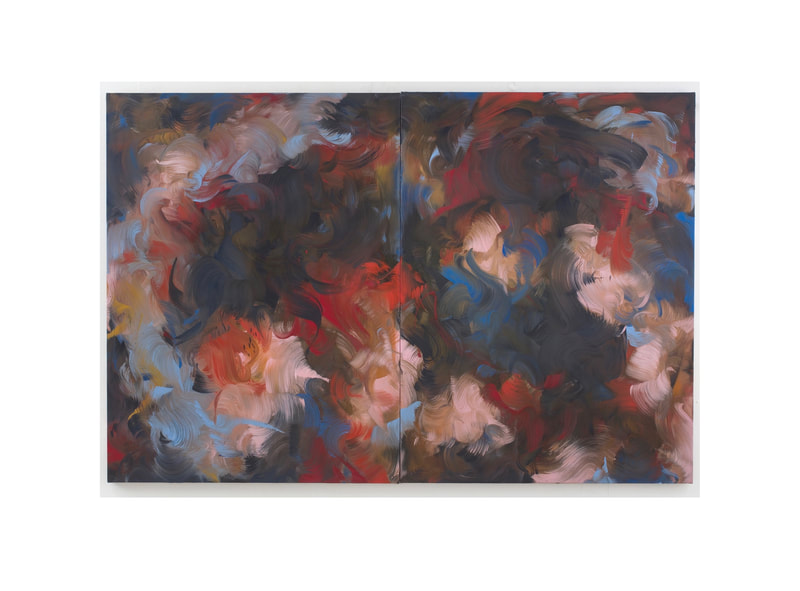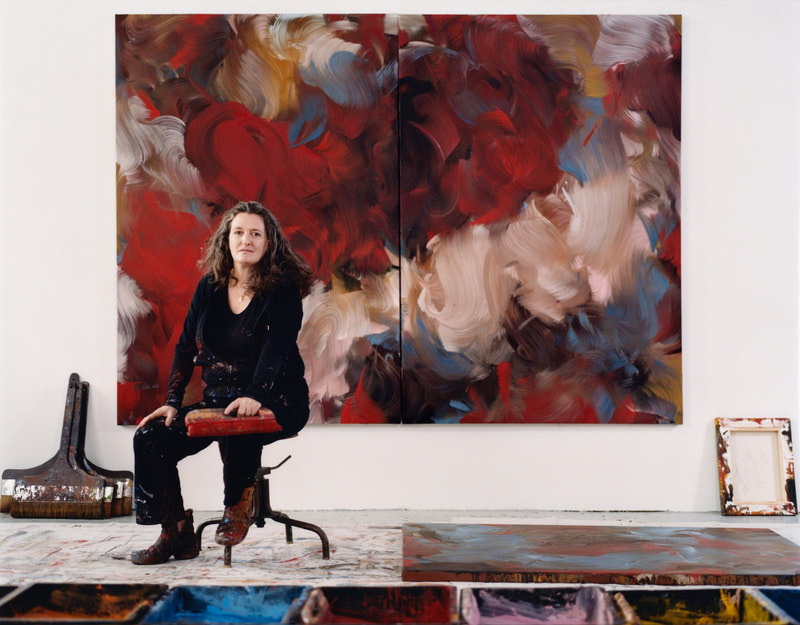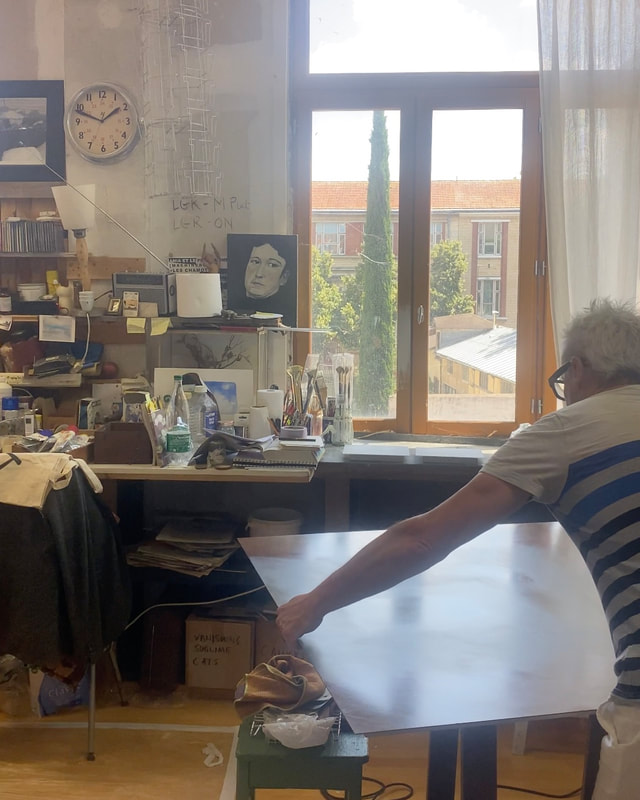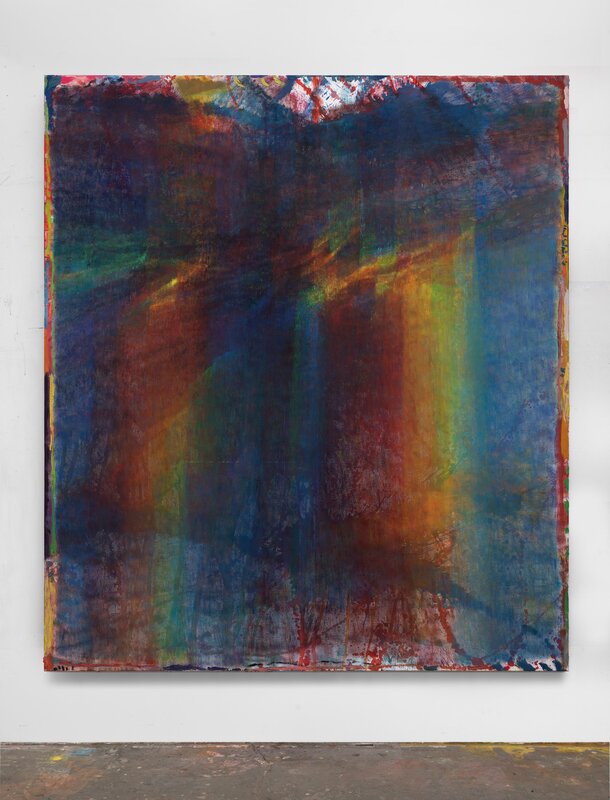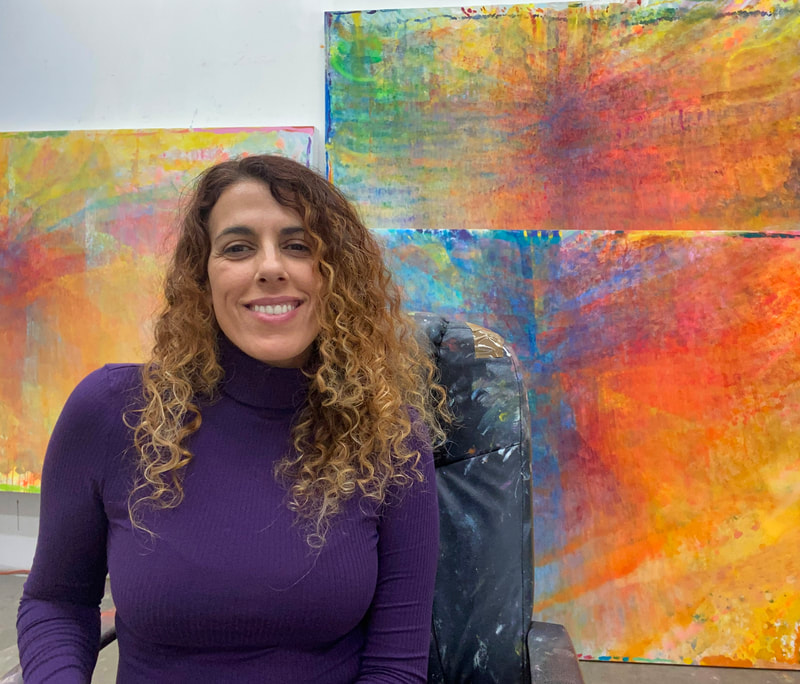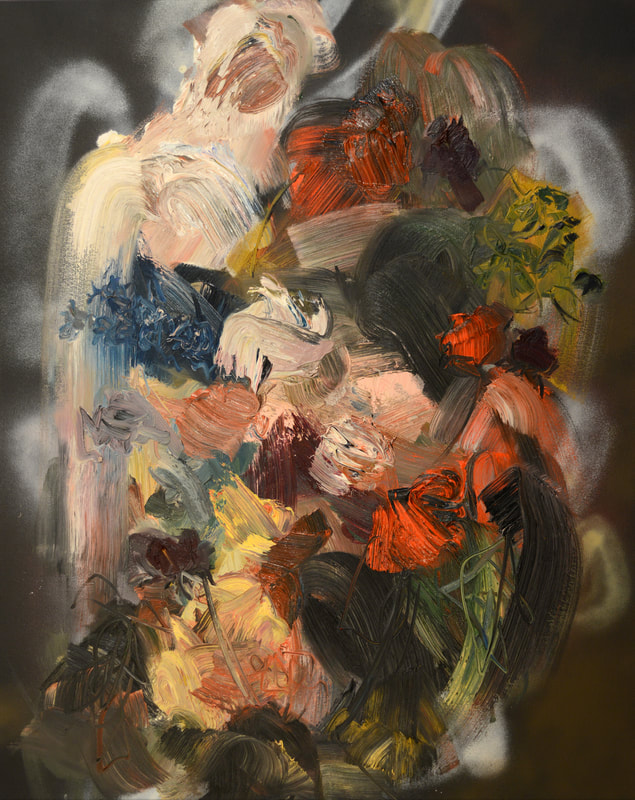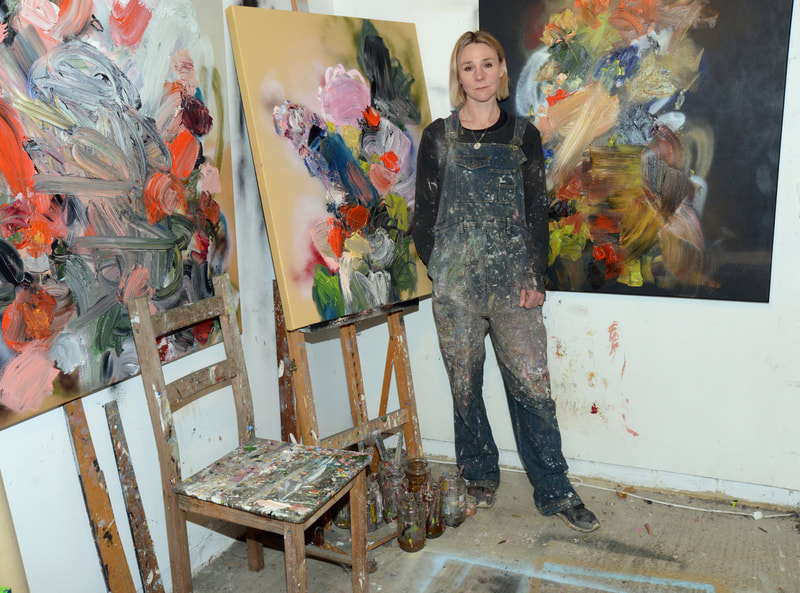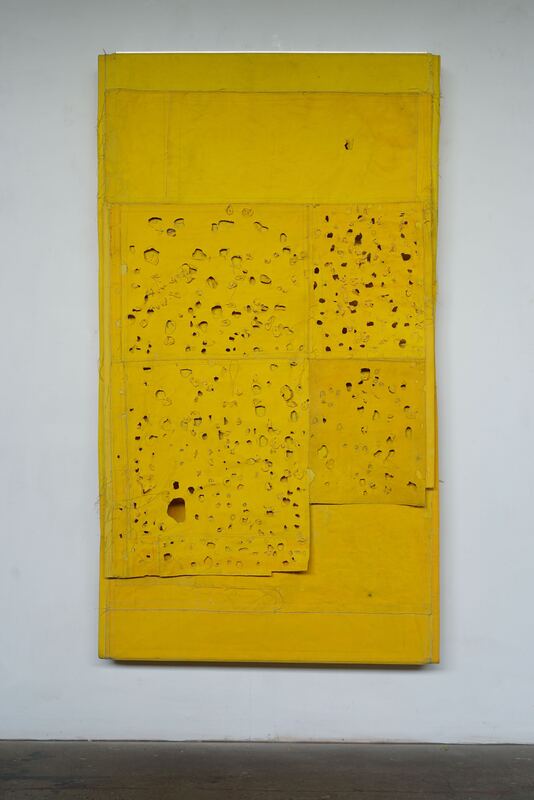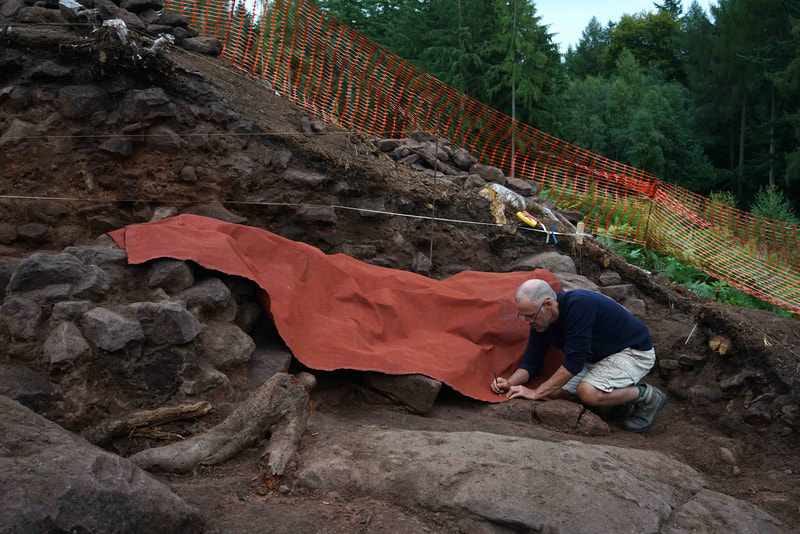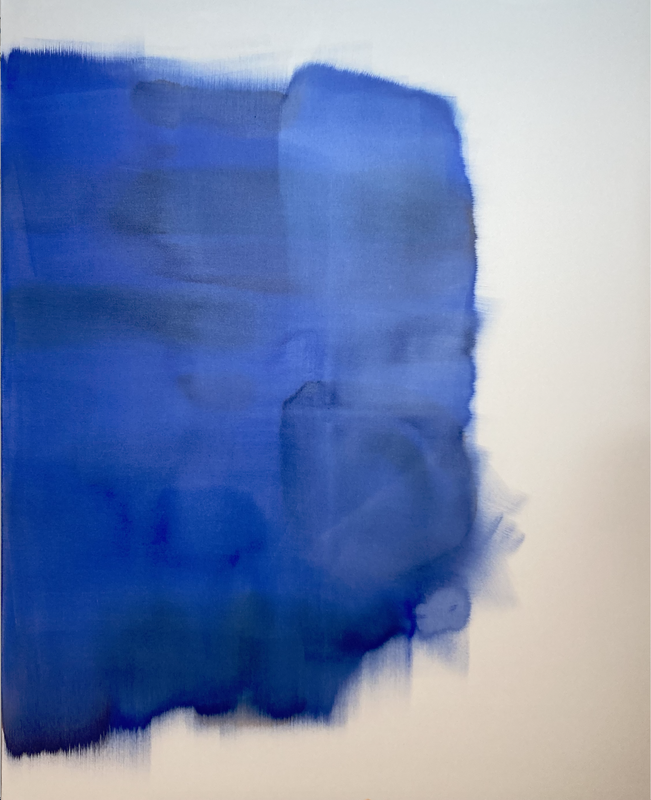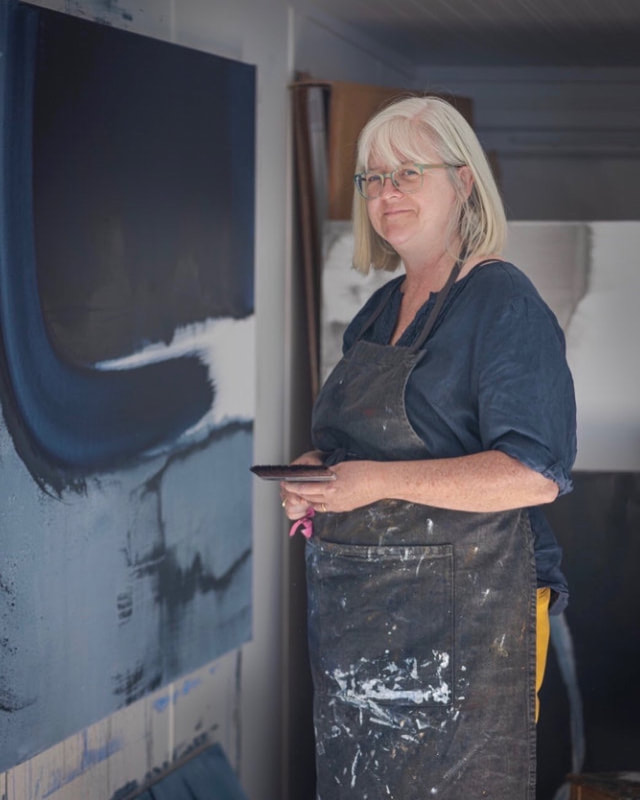A Geography of Colour is a new monthly podcast about painters' relationships with colour. Each month I'll be talking with a painter about their connections with colour and its power in their work. You can find the podcast on Apple Podcasts, Spotify and Soundcloud. You can also find it on instagram @ageographyofcolour
This month on A Geography of Colour I talk with Ruth Calland, a contemporary British painter and also a Jungian analyst, living and working in London.
Emergence and attunement to what is emergent, are the experiences that engage her. She has a deep interest in alchemy, which provides a framework for how she thinks about painting as process. She will often utilise two different points of reference and see them as creating an interactive field, within which she operates in order to investigate their relationship. She has a longstanding interest in gender, and her exploration of gender fluidity in her participative performance project Carnival of Souls took place across the E17 Arts Festival and the Folkestone Triennial in 2013. She presented this work at the conference ‘Alchemy: Exploring Metaphorical Transformations and Arts-Based Research’ at Oxford University in 2023.
In the pandemic she was inspired by the early vampire film Nosferatu, with its monochrome landscapes, haunted by anxiety about infection by the supernatural other. At this time she also began researching trans experiences of being feared and othered, discussed by creators on TikTok. Her current work uses stills from these videos to amplify and celebrate trans voices, using high key colour to celebrate their cultural emergence from the shadows, and a redefinition of what it means to be natural, or true to nature.
Ruth is a member of Contemporary British Painting and has exhibited nationally and internationally, including at Transition Gallery, Flowers East, Doncaster Museum and Art Gallery, Vestry House Museum, Hastings Museum and Art Gallery, and the Dulwich Festival. She has curated shows for APT, Walthamstow Wetlands, and Salthouse Gallery. She was included in the Made In Britain, 80 Painters of the 21st Century, at Yantai Museum, Nanjing and Tianjin in China, and Gdansk, Poland in 2019; she was selected for the New Contemporaries at the ICA and Bluecoat Galleries, was a prize-winner at Southwark Gallery Open, Painting Fellow at Gloucester Art College, a Rome Scholar runner up, Boise Travelling Scholarship winner, and included twice in the Marmite Prize for Painting. In 2022 she was artist in residence atPasture Project Space, Sudbury andrecently a finalist at the Artworks Open 2023, (Barbican Arts Trust). She lectures and writes on creative processes within Jungian psychoanalysis and in 2018 won the Fordham Prize for her paper ‘Race, Power and Intimacy’.
www.ruthcalland.com
Images: Ruth Calland in her studio (copyright: Ruth Philo)
Ruth Calland Self sacrifice Scene, 122 x 183 cm, oil on paper on canvas, 2023 (copyright: Ruth Calland)
Emergence and attunement to what is emergent, are the experiences that engage her. She has a deep interest in alchemy, which provides a framework for how she thinks about painting as process. She will often utilise two different points of reference and see them as creating an interactive field, within which she operates in order to investigate their relationship. She has a longstanding interest in gender, and her exploration of gender fluidity in her participative performance project Carnival of Souls took place across the E17 Arts Festival and the Folkestone Triennial in 2013. She presented this work at the conference ‘Alchemy: Exploring Metaphorical Transformations and Arts-Based Research’ at Oxford University in 2023.
In the pandemic she was inspired by the early vampire film Nosferatu, with its monochrome landscapes, haunted by anxiety about infection by the supernatural other. At this time she also began researching trans experiences of being feared and othered, discussed by creators on TikTok. Her current work uses stills from these videos to amplify and celebrate trans voices, using high key colour to celebrate their cultural emergence from the shadows, and a redefinition of what it means to be natural, or true to nature.
Ruth is a member of Contemporary British Painting and has exhibited nationally and internationally, including at Transition Gallery, Flowers East, Doncaster Museum and Art Gallery, Vestry House Museum, Hastings Museum and Art Gallery, and the Dulwich Festival. She has curated shows for APT, Walthamstow Wetlands, and Salthouse Gallery. She was included in the Made In Britain, 80 Painters of the 21st Century, at Yantai Museum, Nanjing and Tianjin in China, and Gdansk, Poland in 2019; she was selected for the New Contemporaries at the ICA and Bluecoat Galleries, was a prize-winner at Southwark Gallery Open, Painting Fellow at Gloucester Art College, a Rome Scholar runner up, Boise Travelling Scholarship winner, and included twice in the Marmite Prize for Painting. In 2022 she was artist in residence atPasture Project Space, Sudbury andrecently a finalist at the Artworks Open 2023, (Barbican Arts Trust). She lectures and writes on creative processes within Jungian psychoanalysis and in 2018 won the Fordham Prize for her paper ‘Race, Power and Intimacy’.
www.ruthcalland.com
Images: Ruth Calland in her studio (copyright: Ruth Philo)
Ruth Calland Self sacrifice Scene, 122 x 183 cm, oil on paper on canvas, 2023 (copyright: Ruth Calland)
In the eleventh podcast I talk with Mallory Page, a contemporary American painter, based in New Orleans. Her paintings employ multiple layers and hues of acrylic wash that cascade across large scaled canvas. Mallory's interests lie in the study of the psyche, dreams and the subconscious. She often tethers psychic sensations or observations to build work about creating deeper interactions with the sublime. Mallory was raised in Lafayette, Louisiana, a region with a vibrant, often mystical, culture and distinctive geographical landscape. She holds a B.I.D. from Louisiana State University and is currently a candidate for a Master’s in Fine Art from The Art Institute of Chicago.
Mallory Page
Images: Mallory Page portrait and Mallory Page 'Rose Sea (she answered without words)', Sub Rosa, 62"x 72", Acrylic on Linen, 2020, copyright Mallory Page.
In the tenth podcast I talk with Charley Peters, a contemporary British painter, who lives and works in London. She makes paintings where abstract language and screen aesthetics collide, remixing familiar motifs from art history, retro gaming, and internet culture. Charley explores contemporary painting as an expanded practice that is both physical and virtual, and not limited to the surface of a canvas. Although essentially abstract, her works remind us of our real world, suggesting a transition in our ways of seeing from the once-radical non-representation of high modernism to the everydayness of digital imagery. By working in the public sphere as well as in the studio, Charley’s work connects with a diverse range of audiences and reminds us that the power of creativity can change lives, enhance spaces and to experience the world differently.
Charley exhibits internationally, showing recently at Hauser & Wirth (London), Meakin + Parsons (Oxford), Yantai Art Museum (Yantai), and National Museum of Gdansk (Gdansk). Her clients include Meta, ITV, London Art Fair, House of Vans and Hospital Rooms. Charley completed a PhD in Fine Art Theory and Practice and has contributed to writing about painting to online and print publications. She is a visiting tutor at Fine Art at City & Guilds of London Art School, an offsite mentor at Turps Art School and a Postgraduate Senior Lecturer at UAL.
Charley Peters
Images: Charley Peters in her studio (photo: Tom Silvester for Footpatrol)
Charley Peters Hey Hey, Good Game, Oh Wow, Hot Mess (2021), acrylic on canvas, 140cm x 175cm (left); Nothing But Trouble, Who The Hell Cares (2022), acrylic on canvas, 140cm x 175cm,(right) installed in Full Throttle, The Foundry Gallery 2023, copyright Charley Peters
In the ninth podcast I talk with Marius von Brasch, a German-British painter who lives and works on the Isle of Wight. His work highlights the power of unconscious filters that shape perception. Imagination, affects and memories, which pervade social life, history and the life of the soul, play a significant role in the emergence of each painting and work on paper. Marius’s practice aims to translate these layers and their different relationships to time. The emotional dynamics of colour and how to contain and give form to what seems to evade representation are central to the work. Figures and fragmented narratives in the paintings constellate multiple polarities and also, often echoing mythologies, deal with ideological postures prevalent today. He finds parallels to his approach in Renaissance illuminations in alchemical manuscripts and quotes them indirectly in his work. This symbolic alchemical imagery addresses journeys of identities and evolution of consciousness while proposing transformative ways of working with conflict and diversity. Marius’s interest here is to find new painterly ways to speak about these subjects and a dialogue with classical and contemporary painting allows him to be part of an ongoing living tradition.
Marius received his MA with distinction from Winchester School of Art (Uni of Southampton) where he also completed his practice-based PhD in Fine Art Painting. He was awarded the Abbey Fellowship in Painting at The British School in Rome in 2013. With a background in psychotherapy and literature, Marius teaches experiential approaches to painting as well as courses on art and literature. His work is held in the Priseman Seabrook Collection, the University of Essex Modern and Contemporary British Art Collection, and in international private collections. He is represented by Jenn Singer Gallery, New York.
mariusvonbrasch.co.uk
jennsingergallery.com/mariusvonbrasch
James Hillman, The Dream and The Underworld
Carl Jung, Psychology and Alchemy
Images: Studio portrait by Ruth Philo; Marius von Brasch 'Pansy' (Self portrait as a child) copyright Marius von Brasch
In the eighth podcast I talk with Jenny Eden, a Contemporary British painter, writer and lecturer based in the North West of England.
Emerging from a process of close making and the complex relationship between two active objects of being, Jenny’s paintings embody the potential for visual and psychological oscillation. In this exchange between painter and painting, the process arrives at curious and insubstantial 'part-objects', simultaneously ‘separate from’ and ‘part of’ monochromatic spatial fields, operating in obscure, surface-smooth colour (un)realities.
Jenny received a BA in Fine Art from Birmingham School of Art in 2000, an MFA in Fine Art from Manchester School of Art in 2017 and she is currently undertaking a By Practice PhD in Painting at Manchester School of Art. Jenny lectures in Fine Art Painting at Manchester School of Art on the BA Fine Art and MA Painting programmes and she is Level 4 Year Leader in Fine Art. She also co-runs Oceans Apart, a gallery in Salford dedicated to contemporary painting, and she has exhibited her own work both nationally and internationally.
jennyeden.co.uk/
oceansapart.uk/
art.mmu.ac.uk/profile/jeden
ahrc-metamodernism.co.uk/seattle-recordings/
In the seventh podcast I talk with painter Elizabeth Rose Langford. Lizzy Langford is a contemporary British painter who currently lives and works in Ibiza. She has a BA in English and Philosophy from Nottingham University and a BA Fine Art from City and Guilds of London School of Art.
Lizzy’s practise is site responsive: she work’s with stories and materials from the land, using them to make paintings that speak of their origins and suggest another way of seeing and engaging with the natural world. Her motivations are to draw attention to the current global crisis, working with organic matter to discuss unrelenting growth in the name of “progress” and humanity’s consequential dissociation from nature.
Since 2013 Lizzy’s practise has centered around the inherent systems of natural materials. She spent four years after graduating learning traditional methods of extracting colour from plant and earth matter, which her current practise readdresses in an attempt to reveal something previously overlooked in the sole pursuit of pigment. She manifests these concerns with the action of painting, between the site of the pigments and the studio.
Lizzy won the Griffin Art Prize in 2013 working collaboratively with Luke Cranswick and undertook a residency with Winsor and Newton in 2014 precipitating rose madder. Since then she has had solo shows in London, Ibiza and New York, taken part in numerous group shows and undertaken various residencies in Europe, the US and the UK. She is currently working on ‘REDiscover a research project with NOVA University Lisbon and UCL London. Lizzy is representated by Katrina Phillips, London.
Images: copyright Elizabeth Rose Langford.
In the sixth podcast I speak with painter Erin Lawlor . Erin Lawlor is a contemporary British painter who lives and works in London. After receiving her BA History of Art in 1992 from the Sorbonne University Paris, Erin was based in France until 2013 when she returned to the UK.
Since her first solo show in Paris in 2010, she has exhibited extensively around the world. Recent solo gallery exhibitions have included 'Earthly Delights' at Vigo Gallery, London in 2023 and solo shows at Miles McEnery Gallery, New York in 2022, at Luca Tommasi in Milan in 2021 and at Fox/Jensen/McCrory Gallery, Auckland, in 2020. In 2017 a survey exhibition of Erin’s work ‘Onomatopoeia' took place at the Mark Rothko Centre, Daugavpils, Latvia, and her work was showcased in 'Maleri.Nu/Paint.Now' at the Ny Carlsberg Glyptotek Museum, Copenhagen in 2016. Earlier in 2023 she had her first institutional exhibition in the UK, ‘Invincible Summer’ at Wellington Arch, London in partnership with Apsley House and English Heritage.
In a recent catalogue essay David Anfam speaks of Lawlor’s paintings as ‘Cutting-edge contemporary, her work nevertheless has roots as deep and distant as Ovid’s Metamorphoses in which being is forever in a state of becoming.’
Erin’s work is in numerous public and private collections include the Women’s Art Collection, Cambridge, UK; the Mark Rothko Centre, Latvia, and the Kolon Museum Collection, Seoul. She is represented by Vigo Gallery, London; Miles McEnery Gallery, New York; Fox/Jensen and Fox/Jensen/McCrory galleries, Sydney and Auckland, and Luca Tommasi, Milan.
Images: Erin Lawlor 'earthly delights' oil on canvas, 2023, (photo: Colin Mills) and Erin in her studio (photo: Peter Mallet), copyright: Erin Lawlor.
In the fifth podcast 'A Geography of Colour' I talk with painter Siemon Scamell-Katz . Siemon is a contemporary British painter, who has recently moved to France, living and working between La Soutteraine and Paris.
Siemon’s practice is based on an understanding of the way humans see. In his mid-twenties, he launched a business that researched human behaviour and pioneered eye tracking, a technique which allowed him to understand how we see – and interpret what we see. Rejecting realistic painting or photography as 'a false record of experiential reality', he has discarded everything representative and iconographic. Instead, he uses his knowledge of human vision to create works that draw their viewers in, allowing them to experience the fundamental feeling of the represented landscape and the Sublime, often in a deeply spiritual way. His paintings are non-figurative, abstracted from place and landscape in oil and enamel on aluminium – his process aims to remove both the frame and the icon so that the viewer is asked to look without seeing but feeling.
Recently Siemon has been working at Giverny, the landscape of Claude Monet and Joan Mitchell. There is an interesting article on his work, Light Seconds: The Untimely Brilliance of Siemon Scamell-Katz by Shannon Forrest in Art Forum, 23 June 2023
Images: Siemon Scamell-Katz 22:04, 2023, oil and enamel on aluminium, 48 x 48” and Siemon in his studio (copyright: Siemon Scamell-Katz)
In the fourth podcast I talk with Rema Ghuloum. Rema is a contemporary American painter who lives and works in Los Angeles, CA. She makes vibrant abstract paintings that have many layers, built up and sanded down to reveal their archaeologies.
Earlier this year Rema had her second solo show 4 is a Rainbow Line at Et al, a gallery in San Francisco. The gallery described her work as being ’an index of colour - woven, translucent layers singing with and through each other; spectral stratum, a chorus of colour. Rema’s work is heart-felt, joyous, devotional. The paintings sing.’
She received her BFA in Drawing and Painting from California State University, Long Beach in 2007 and her MFA from California College of the Arts in San Francisco in 2010. Rema has exhibited nationally and internationally and has been the recipient of multiple grants including the Pollock-Krasner Foundation Grant, the Joan Mitchell Foundation Grant, Davyd Whaley Foundation Artist-Teacher Grant, and the Esalen Pacifica Prize. Rema’s work has been reviewed in Art Forum, Hyperallergic, CARLA, the Los Angeles Times, Fabrik, among others. Rema Ghuloum is represented by Philip Martin Gallery in Los Angeles.
Images: Rema Ghuloum 4 is a Rainbow Line, 82 x 72 inches, 2022-23 and R.ema in her studio (copyright: Rema Ghuloum)
In the third podcast I talk with Miranda Boulton, a contemporary British painter who lives and work in Cambridge, UK. She studied Art History at Sheffield Hallam University and at Turps Banana Art School in London.
In 2021 she won the Jacksons Painting Prize. Notable exhibitions include: Royal Academy Summer Exhibition 2016 & 2019, Creekside Open 2019, ING Discerning Eye 2021 and the Young Masters Autumn Exhibition 2022.
She describes her paintings as Nature Morte of flora. Her work is a response to historical references within this genre. Art historical images are translated through memory into a contemporary pictorial language, linked through expressive colour, gesture and form. Each painting is an ongoing conversation between past and present, an exploration of new forms from old imagery and narratives. Painting for Miranda is a complex and endlessly fascinating medium.
Images: Miranda Boulton Ghosts and Flowers III, 2022, 100 x 80cm, oil and acrylic spray paint on canvas,
Courtesy of Cynthia Corbett Gallery and Miranda in her studio.
In the second podcast I talk with painter Simon Callery. Simon challenges what painting can do today. He makes work that exists on the margins of what can be understood as painting. On his studio wall is written the word ‘INVERT’ to remind him every day to subvert the established conventions of image-based painting, to find new roles and develop new forms for painting. He intends that an encounter with one of his paintings is as much for the body as it is for the eye. Simon has worked in the landscape alongside field archaeologists on many projects and applies the knowledge he find here to works made in the urban environment and also to developing studio based work. The visceral qualities of the excavation sites have made him sensitive to the physical qualities of landscape and the relationship of material to time. He embraces the fact that his paintings share spatial qualities we associate with sculpture. Images below Simon Callery Yellow Reworked, 2018 – 2022, canvas, distemper, thread, pencil, wood, aluminium, 188 x 105 x 20 cm and Simon working on site, © Simon Callery. All Rights Reserved, DACS/Artimage 2023.
In the second podcast I talk with painter Simon Callery. Simon challenges what painting can do today. He makes work that exists on the margins of what can be understood as painting. On his studio wall is written the word ‘INVERT’ to remind him every day to subvert the established conventions of image-based painting, to find new roles and develop new forms for painting. He intends that an encounter with one of his paintings is as much for the body as it is for the eye. Simon has worked in the landscape alongside field archaeologists on many projects and applies the knowledge he find here to works made in the urban environment and also to developing studio based work. The visceral qualities of the excavation sites have made him sensitive to the physical qualities of landscape and the relationship of material to time. He embraces the fact that his paintings share spatial qualities we associate with sculpture. Images below Simon Callery Yellow Reworked, 2018 – 2022, canvas, distemper, thread, pencil, wood, aluminium, 188 x 105 x 20 cm and Simon working on site, © Simon Callery. All Rights Reserved, DACS/Artimage 2023.
The first podcast in the series is with Sarah Needham. Sarah lives and works in North London. Her work is concerned with the way in which pigments leave material colour across human history and geography and traces of our interactions. Often something happening now prompts her research into a historical event or place and her paintings develop from this. Sarah make oil paints by hand from pigments and often sources these in the landscape relevant to a particular project. There is a sense in which these colours hold nuance and space for connection as well as symbolism. Her work is abstract and she describes her paintings as ‘spaces to fall into’. Images: Sarah Needham Parallel Strata , hand made oil on canvas 120 x 150cm and Sarah in her studio, painting.
